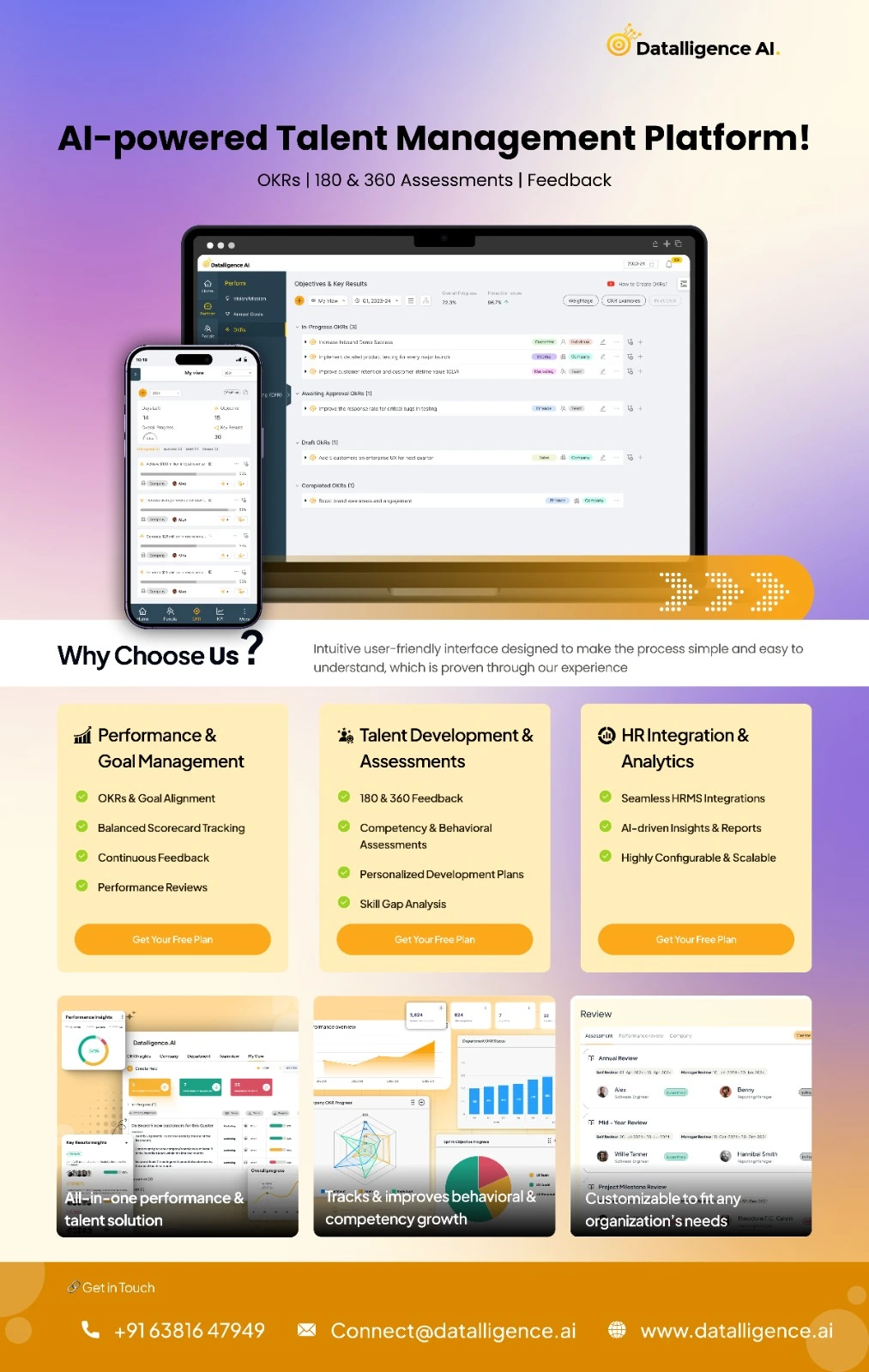According to a study by Gallup, only 14% of employees strongly agree that their performance reviews inspire them to improve. This statistic highlights the need for organizations to rethink their appraisal methods to ensure they are meaningful, engaging, and growth-oriented. A well-designed performance appraisal Methods not only assesses employee performance but also provides a roadmap for career development and organizational success.
Performance appraisal methods are a critical component of organizational success, serving as a key tool in the ongoing development of both employees and the organization as a whole.
Here’s a more detailed breakdown of why performance appraisals are essential:
Identify Employee Strengths and Areas for Improvement
Performance appraisals provide a structured way to assess individual employees’ work, helping managers identify their strengths and weaknesses. Regular feedback allows employees to recognize their achievements and understand where they may need improvement. This creates an opportunity to focus on:
- Skill development: Identifying areas where training or upskilling is needed.
- Better task delegation: Understanding where each employee excels helps in assigning roles that match their skills, leading to better outcomes.
Enhance Motivation and Engagement
Recognition of contributions is a powerful motivator. When employees receive positive feedback during performance appraisals, it validates their hard work and dedication. This recognition not only boosts morale but also:
- Encourages continued effort: Employees who feel valued are more likely to stay engaged with their tasks and work harder.
- Fosters a positive work environment: Acknowledging achievements fosters a culture of appreciation, which can lead to increased collaboration, creativity, and a stronger sense of team spirit.
Provide a Clear Roadmap for Career Progression and Development
Performance appraisals give employees a clear understanding of their current standing within the organization and the potential paths available to them. It allows both employees and managers to have:
- Focused development plans: Employees can set goals for personal and professional growth, with the necessary support from managers to achieve these goals.
- Career trajectory clarity: Understanding the expectations for higher roles allows employees to work toward promotions, making it easier for them to stay motivated and focused on long-term career goals.
Align Individual Goals with Organizational Objectives
Performance appraisals ensure that employees’ efforts align with the broader goals of the organization. By setting clear objectives and key results (OKRs) during the appraisal process, organizations can:
- Align work efforts: When employees understand how their tasks contribute to larger business goals, it enhances their sense of purpose and accountability.
- Track progress: This alignment helps managers monitor whether the work being done is effectively contributing to the company’s objectives, making it easier to adjust strategies when needed.
Support Fair Compensation, Promotions, and Succession Planning
Performance appraisals are essential for making fair and data-driven decisions about employee compensation, promotions, and future leadership roles. Appraisals provide:
- Objective evaluation: By measuring employee performance against clear criteria, appraisals remove biases, ensuring fair decisions regarding pay raises or promotions.
- Succession planning: Identifying top performers during the appraisal process allows organizations to plan for the future and groom high-potential employees for leadership roles.
Without a Structured Appraisal System, Risks Increase
Without a clear and structured appraisal process, organizations face several risks, including:
- Low employee morale: Employees may feel overlooked or undervalued if there is no formal recognition of their work. This can lead to disengagement and decreased productivity.
- Unclear expectations: Without regular feedback, employees might not fully understand their job requirements or how their performance impacts the organization, leading to confusion and inefficiency.
- Difficulty in tracking performance improvement: Without appraisals, it becomes harder to identify trends in employee performance or determine whether improvement initiatives are working.
How to Write a Performance Appraisal
Writing a performance appraisal requires a balance between objectivity and constructive feedback. Here’s how to craft an effective appraisal:
- Define Clear Objectives – Begin by outlining the key goals and expectations for the employee. A well-defined objective helps in assessing performance against specific criteria rather than general impressions.
- Use Data-Driven Insights – Rely on measurable performance metrics, such as sales numbers, project completion rates, customer satisfaction scores, and KPIs relevant to the role. This ensures fairness and reduces subjectivity.
- Provide Constructive Feedback – An appraisal should highlight both strengths and areas that need improvement. Instead of generic feedback, provide specific examples of accomplishments and areas where the employee can enhance their skills.
- Encourage Open Communication – A performance review should be a two-way conversation. Encourage employees to share their perspectives, challenges, and aspirations. This creates a collaborative and growth-focused environment.
- Set Future Goals – The appraisal should conclude with clear action steps for future improvement. Goals should be SMART (Specific, Measurable, Achievable, Relevant, and Time-bound) to ensure clarity and trackability.
How to Fill a Performance Appraisal Form
Completing a performance appraisal form requires attention to detail and objectivity. The key sections include:
- Personal Information & Job Role – Fill in the employee’s name, designation, department, and tenure to provide context for the review.
- Performance Ratings – Most forms include a rating system (e.g., on a scale of 1 to 5) for various competencies such as teamwork, communication, problem-solving, and job knowledge.
- Accomplishments & Contributions – This section highlights the employee’s key achievements, completed projects, and any contributions that positively impacted the organization.
- Areas for Improvement – Identify any gaps in skills, behavior, or performance that need attention. This should be framed constructively, with a focus on growth and development.
- Supervisor & Peer Feedback – Many appraisal forms include inputs from managers, colleagues, or even clients to provide a well-rounded assessment of the employee’s performance.
- Goal-Setting & Development Plan – The final section should include short-term and long-term goals, along with any necessary training, mentoring, or resources to help the employee succeed.
6 Effective Methods to Run Performance Appraisals
Performance appraisals are a cornerstone of effective employee development and organizational growth. By using the right method, organizations can ensure fair, accurate, and meaningful evaluations that benefit both employees and the company. Below are six proven performance appraisal methods that can be tailored to fit various organizational needs:
360-Degree Feedback
360-degree feedback is a comprehensive appraisal method that gathers input from multiple sources to assess an employee’s performance. Feedback is collected from a variety of stakeholders, including peers, direct reports, supervisors, and even the individual’s self-assessment. This holistic approach provides a well-rounded view of the employee’s strengths and areas for improvement.
Benefits:
- Reduces bias: By collecting feedback from multiple sources, the risk of one-sided or biased assessments is minimized.
- Improves self-awareness: Employees get a broad perspective on their behavior and performance from those who interact with them regularly.
- Encourages development: Feedback from different angles helps employees identify blind spots and target areas for personal growth.
Best for: Organizations that emphasize teamwork, cross-functional collaboration, and holistic employee development.
Management by Objectives (MBO)
Management by Objectives (MBO) is a goal-oriented appraisal method where employees and managers collaboratively set clear, measurable objectives that are aligned with the organization’s strategic goals. Throughout the appraisal period, managers and employees periodically review progress toward these goals.
Benefits:
- Aligns individual and company goals: By setting objectives that support broader company objectives, employees can see the impact of their work on the organization’s success.
- Measurable results: Objectives are typically quantifiable, making it easier to assess performance objectively.
- Continuous improvement: Periodic reviews ensure that any obstacles to goal achievement can be identified and addressed early.
Best for: Organizations that prioritize clear, quantifiable goals and results-driven performance.
Behaviorally Anchored Rating Scales (BARS)
The Behaviorally Anchored Rating Scales (BARS) method evaluates performance based on specific behaviors and actions rather than abstract traits. For each performance level, predefined behavioral descriptions are created, helping managers assess performance more accurately. Instead of simply rating an employee on a scale (e.g., 1-5), BARS provides detailed examples of what performance looks like at different levels, offering a clear framework for assessment.
Benefits:
- Increased accuracy: By focusing on specific behaviors, BARS reduces the subjectivity of traditional rating systems and provides clearer expectations.
- Clear expectations: Employees understand the exact behaviors required to perform at each level, facilitating better performance.
- Focused feedback: Managers can provide concrete examples when giving feedback, making it more actionable and easier to understand.
Best for: Roles where specific behaviors are critical for success, such as customer service or sales positions.
Self-Assessment
Self-assessment is a reflective appraisal method where employees evaluate their own performance. This encourages individuals to look critically at their work, identify their strengths, and acknowledge areas for improvement. Self-assessments are often part of the formal appraisal process, but they can also be used independently to promote self-awareness and personal growth.
Benefits:
- Promotes self-awareness: Employees gain insight into their strengths, weaknesses, and progress toward goals.
- Encourages ownership: By reflecting on their own performance, employees take greater responsibility for their development.
- Facilitates discussion: Self-assessments often form the basis for constructive discussions during performance reviews, making feedback more collaborative.
Best for: Organizations focused on employee growth, accountability, and self-driven development.
Continuous Feedback System
In contrast to annual reviews, the continuous feedback system emphasizes ongoing, real-time feedback throughout the year. Managers regularly check in with employees to discuss their progress, provide feedback, and address any challenges. This approach allows for more dynamic and timely responses to performance issues.
Benefits:
- Proactive feedback: Employees receive timely guidance, helping them make adjustments before performance issues become ingrained.
- Fosters a growth mindset: Ongoing feedback helps employees continuously develop and improve, rather than waiting for an annual review to understand their performance.
- Enhances engagement: Frequent check-ins show employees that their development is a priority, improving engagement and motivation.
Best for: Organizations looking for an agile, dynamic approach to performance management, particularly in fast-paced environments.
Critical Incident Method
The Critical Incident Method involves documenting specific, significant events that occur during the appraisal period. These incidents—both positive and negative—serve as examples of an employee’s performance, providing concrete evidence during the review. Managers record these incidents as they occur, then use them to highlight specific behaviors and outcomes during the appraisal discussion.
Benefits:
- Clear, actionable feedback: Specific incidents make the feedback more tangible and actionable, rather than vague or generalized.
- Evidence-based: The method relies on real examples, making it easier to justify ratings and decisions.
- Objective: By focusing on specific incidents, this method removes some of the subjectivity that can creep into performance reviews.
Best for: Roles where critical performance events (both positive and negative) can be easily identified, such as customer-facing or operational positions.
By implementing these methods, organizations can enhance their performance management system, foster employee growth, and drive business success. A well-executed appraisal process not only evaluates past performance but also paves the way for future development and achievement.
Conclusion
Choosing the right performance appraisal method depends on an organization’s goals, culture, and the nature of the roles being assessed. Whether it’s through comprehensive 360-degree feedback, clear goal setting with MBO, or continuous, real-time feedback, each method provides unique benefits that can help improve employee performance and contribute to organizational success. By using a method that aligns with both company objectives and employee development needs, organizations can foster a more engaged, motivated, and high-performing workforce.











